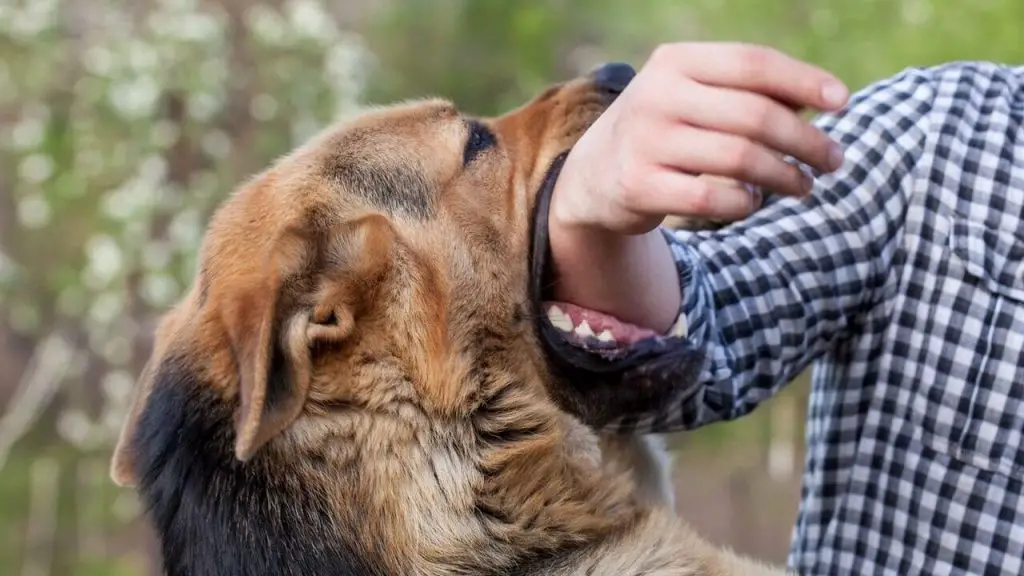Your dog is one of your best friends. Even if he does occasionally try to eat your shoes or sniff your private parts when you least expect it. You know your relationship with him is special because at that time you caught him red-handed and he sheepishly licked the floor in a feeble attempt to avoid being punished. If only we could all have such embarrassing friends.
As much as we love dogs, however, they do have their dangers and there’s no better example than a dog bite. The risk of being bitten by a dog is ever present and can happen at any time, even if it’s not something you would expect from your friend. Let’s take a look at what does a dog bite look like, how to treat it, and what steps you can take to prevent getting bitten again in the future.
What to Expect When You Get Bitten by a Dog

Dog bites come in many shapes and sizes, and they can be as painful as they are dangerous. If you have ever been bitten by a dog, then you know how traumatic the experience can be. Getting bitten can lead to nasty infections and even a potential loss of limb, depending on the circumstances of the bite.
The most common dog bites are to the extremities, such as the hands and legs, but bites can occur anywhere on the body. If a dog is aggressive, it’s likely it will bite you. However, if a dog is scared and feeling threatened, it might also bite you as a last resort.
Unfortunately, there’s no way of knowing whether or not a dog is aggressive before it bites you. Even the friendliest, cutest dog in the world can bite you out of fear or aggression. When they do, they leave behind nasty cuts and bruises that can take weeks to heal.
How Bad Are Dog Bites?
Dog bites are bad, but some are worse than others. If you have been bitten by a dog, it’s important you know how bad the bite is before seeking medical treatment. There are different levels of dog bite wounds, and each level has its own set of symptoms. The level of your bite wound will determine the treatment you need, so it’s important you know what to expect.
A wound that is classified as a “first-degree” dog bite is the least serious. A first-degree dog bite will not break the skin, but it may cause an infection. A “second-degree” dog bite will break the skin and cause an open wound. Second-degree dog bites can cause excessive bleeding, scarring, and a higher risk of infection.
The most serious dog bites are the “third-degree” ones. A third-degree dog bite will cause a deep wound that goes all the way through the muscle and into the bone. A third-degree dog bite can cause serious injury to the surrounding tissue and even lead to amputation.
Recovery Time
The time it takes for a dog bite to heal will vary depending on the severity of the wound. If you have suffered a third-degree dog bite, you may need to spend months in a cast and on antibiotics.
A first-degree dog bite, on the other hand, may take only a few days to heal. In most cases, dog bite wounds will take around two weeks to heal. During this time, you will have to apply an ice pack to reduce swelling and pain. You will also need to keep the wound clean and protected so it can heal properly.
How to Care for a Dog Bite
Dog bites are nasty wounds that will take time to heal. To treat your bite wound, you should follow these steps:
- Remove the dog saliva – You will need to remove any dog saliva from the wound to prevent infection.
- Wash the wound – Use warm water to gently clean the wound. Be careful when cleaning the wound as you do not want to cause yourself further pain.
- Apply an ointment – You can apply an ointment to the wound to prevent infection.
- Put on a bandage – To keep the wound clean and protected, apply a bandage over the wound.
Tips for Avoiding Dog Bites in the Future
If you have been bitten by a dog, it’s likely your first instinct is to avoid dogs forever. While understandable, this may be a bit extreme and unhelpful. Getting bitten by a dog is a traumatic experience, but you can help to avoid it from happening again in the future.
Here are a few ways you can protect yourself from dog bites in the future:
- Don’t approach a dog you don’t know – If you see a dog you don’t know, don’t approach it. Dogs that are not yours may bite you, so walk away and find a different route.
- Avoid dogs when they are eating – Dogs are very territorial while they eat, so they may try to bite you if you get too close.
- Stay away from dogs when they are sleeping – Same as eating, dogs may try to bite you if you try to wake them up or pass by them when they are sleeping.
Conclusion
Dog bites are common, with an estimated 2.5 million people in the United States being bitten every year. This makes it the number one leading cause of injury-related deaths for children, adults, and seniors.
While a dog bite can be scary, it’s important that you know what to expect and what you can do to help the healing process.
Dog bites are classified at different levels based on the severity of the injury. The most severe is known as “third-degree” dog bites, which have gone all the way through the skin and into the bone.
Fortunately, most dog bites are not as bad as they seem. The majority of them are only second-degree or first-degree and will only leave a small wound that can be treated at home. However, if you have been bitten by a dog, then it’s important you know what to expect and what you can do to help the healing process.
FAQs
Are dog bites dangerous?
The least serious injury is one caused by a “first-degree” dog bite. Although a dog bite in the first degree won’t break the skin, it might infect it. A “second-degree” dog bite will result in an open wound and skin breakdown.
Dog bites in the second degree can result in severe bleeding, scars, and an increased risk of infection. The “third-degree” dog bites are the most severe. A third-degree dog bite results in a severe wound that penetrates the muscle and the bone.
What is the recovery time of a dog bite?
Depending on how bad the wound is, a dog bite will take a different amount of time to recover. If you were bitten by a dog in the third degree, you might need to take antibiotics and wear a cast for several months.
On the other hand, a first-degree dog bite might heal in a matter of days. Typically, it takes two weeks for dog bite wounds to heal. You must use an ice pack during this period to lessen pain and swelling.
Additional Contents



